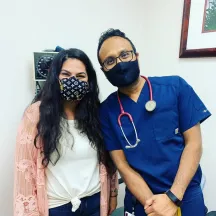Why the doctors chose robotic-assisted surgery
With so many different technologies and treatments available to colorectal cancer patients today, it can be difficult to sift through information and find the option that is right for you. What if you were a patient who was also a doctor yourself? How might this change the way you think about your treatment options?
In the case of Dr. Paul O'Rourke – a 39-year-old, stage I rectal cancer survivor, and physician at Johns Hopkins – robotic-assisted surgery (RAS) was the surgical option he was fortunate he had.
“A lot of current evidence shows similar benefits between RAS and laparoscopic surgery for cancerous tissue removal,” Dr. O’Rourke said. “But one of the real benefits of minimally invasive surgery is smaller incisions and faster recovery time. I was very thankful when the robot became available as an option for my surgery. I believe it really helped me recover quicker and may have helped with my overall pain management.”
From Doctor to Patient
Being a doctor provides you with a wealth of medical information. It’s not always easy, however, to become the patient yourself.
“It was a transformative experience being a cancer patient and a primary care doctor,” Dr. O’Rourke said. “My own primary care physician (PCP) recently left her practice, leaving me without one. Even though I work with amazing colleagues, I felt uncomfortable reaching out to them when my primary doctor was no longer available, as I didn’t want to bother them. When I was experiencing symptoms, it took time to get established with a new PCP.”
Initially, when Dr. O’Rourke spoke to his new primary care physician about his symptoms, his doctor did not feel a colonoscopy was necessary due to his young age and lack of family history. However, Dr. O’Rourke felt that something was off, and ultimately got a colonoscopy ordered.
“They found a mass in my rectum and the pathology came back a few days later with my diagnosis,” Dr. O’Rourke said. “The next few weeks were the scariest. I’d cared for others with cancer before, but didn’t know how to be a cancer patient myself. There was so much uncertainty around my diagnosis and I was worried what this would mean for my family. Being in similar shoes as some of my patients was a humbling experience for me.”
Preparing for Surgery
Preparing for surgery with a cancer diagnosis is difficult for anyone. Being a doctor certainly doesn’t make it any easier.
“It was stressful with all of the scans and tests that needed to be done,” Dr. O’Rourke said. “Fortunately, there was no evidence of metastatic spread. I met with my surgeon, Dr. Najjar, and could tell he really cared. He went through all of the options and potentials, and it helped put my wife and I’s minds at ease.”
Dr. O’Rourke is not only a doctor and husband, but also a father to two young boys. He knew he wanted to get back to living an active lifestyle as soon as possible.
“Dr. Najjar recommended either robotic-assisted surgery or laparoscopic for my case,” Dr. O’Rourke said. “Initially, I was scheduled for laparoscopy, as it was the only option available at the time. However, this changed closer to my surgery date when my doctor was able to secure access to the robot at Johns Hopkins. I ended up having robotic-assisted surgery on November 18, 2022, and I’m so glad I did.”
Dr. O'Rourke's Partial Colectomy
Dr. O'Rourke's surgery lasted a total of four hours. While he was open minded to whatever surgical options became available to him, he was incredibly pleased with the results of his robotic assisted procedure.
“Honestly, my surgeon did an incredible job,” Dr. O’Rourke said. “What’s so striking to me is that from the time I woke up from the procedure the pain was really well managed. I think a lot of that was due to it being a minimally invasive surgery approach, allowing for smaller incisions, faster recovery times, and reduced pain overall.”
Dr. O’Rourke wasn’t the only one glad he was able to get robotic assisted surgery. His surgeon – Dr. Najjar – believes it was a great option for him, as well.
“Paul was an ideal candidate for robotic-assisted surgery,” Dr. Najjar said. “It was a textbook cancer surgery, and we were able to give him a great operation through tiny incisions with the assistance of the robot. While it would have been quite reasonable to do the operation laparoscopically, I think that the robot helped to shorten his hospital stay, and decreased his recovery time.”
Dr. O’Rourke was particularly impressed by the lack of pain he experienced post-surgery.
“I had great pain control with just over-the-counter nonsteroidal anti-inflammatory drugs,” Dr. O’Rourke said. “I don’t think anyone is ever ready for a cancer diagnosis, but being able to get the treatment I needed and get back to playing with my boys meant the world to me. Honestly, I felt so much gratitude after the surgery, and I credit a lot of that to my surgical team and being able to use RAS.”
Surgery is only one piece to the puzzle, with recovery time that comes afterward. However, Dr. O’Rourke was walking the day after the procedure.
“I was out of the hospital in three days and back to my normal routine – including being back at work – within 6 weeks,” Dr. O’Rourke said. “Even before then, I was feeling great and playing board games with my boys. My pain was very well controlled and I stopped taking over-the-counter pain meds within a week.”
Understanding the Benefits of RAS
Understanding the benefits of RAS is greater than just looking at the success story of Dr. Paul O’Rourke. Dr. Najjar, a fellowship-trained RAS surgeon, helps explain some of the advantages of robot-assisted surgery.
“RAS enables me to offer a minimally invasive approach with the same (or better) outcomes that we would have otherwise had with a larger incision,” Dr. Najjar said. “It’s particularly useful for colorectal cancer patients with tumors deep in the pelvis that would be difficult or impossible to access with traditional laparoscopy.”
A study published in 2018 showed improved outcomes when comparing RAS with laparoscopic surgery for colorectal cancer patients. The amount of blood loss, complication, mortality, bleeding rate, and the length of hospital stay was found to be less in RAS patients, overall, although not statistically significant.
Robotic-assisted surgery is known to:
- Enhance dexterity, precision, and maneuverability with the use of lifelike robotic arms;
- Improve visualization through high-definition 3D technology;
- Reduce surgeon fatigue.
“Another advantage of the robotic approach is it can allow for the creation of bowel connections within the body because of the minute wrist movements that make it so much easier,” Dr. Najjar said. “I’m able to manipulate the intestines less, incisions can be smaller, and recovery time will likely be shorter and less painful. While we still await robust data, I do think it can also help reduce problems with urinary or sexual dysfunction because the 3D visualization helps me spare nerves more effectively.”
Increasing Awareness of Robotic-Assisted Surgery
Robotic-assisted surgery can be a game changer for patient quality of life and overall surgery outcomes, especially when talking about colorectal cancer.
“Some of the top outcomes that I see as a result of using RAS with colorectal cancer patients is being able to recover bowel function sooner,” Dr. Najjar said.
In fact, a study published in 2020 showed that RAS allowed rectal cancer patients to have faster bowel function recovery as opposed to laparoscopic.
However, not all patients are aware that this is an option. Some may also have reservations about what the process looks like and how to go about it.
“It’s increasingly common in training programs,” Dr. Najjar said. “I learned during my surgical training and fellowship. It’s not right for every patient, but the robot can be a very useful tool.”
How To Find a Robotic-Assisted Surgeon
It’s important to remember the emphasis on assisted. A professional surgeon will still be controlling all of the robot’s functions and completing the operation.
“You still need an experienced surgeon who you feel comfortable with who will take the approach they feel is the most optimal for your case,” Dr. Najjar said.
For some, robotic-assisted surgery may be a great option they might not have been aware of. If you or someone you know might be interested in utilizing RAS technology, the following steps can be taken:
- Research hospitals and medical centers in your area. Larger hospitals or academic medical centers are more likely to have RAS technology available. Many institutions highlight robotic-assisted surgery programs on their websites, and you can also call them directly to ask. Alternatively, you can use Intuitive’s provider locator (this link will direct you to an external 3rd party website) to find a robotically trained surgeon near you.
- Consult with your primary care physician and discuss your interest in RAS. Your doctor may be able to provide you with a list of surgeons in your area who utilize robotics or refer you to one directly.
- Seek recommendations. If you have any friends or family in the medical field or a support group for your specific diagnosis (ie: Colorectal Cancer Alliance), these are great resources to seek out additional information.
- Research surgeon credentials and schedule consultations. Reaching out for an initial consultation does not lock you into any decision and it’s a great opportunity to explore all of your options.
Of course, as with any medical decision, it’s important to find the option that is right for you.
“I think it’s incredibly important to find a colorectal surgeon that you trust and feel you have good communication with,” Dr. O’Rourke said. “You’ll want to go over the risks and benefits of any procedure. In my case, it provided my wife and I with tremendous peace of mind.”
Raising Awareness About CRC & Getting Involved
Dr. O’Rourke is now a member of the Colorectal Cancer Alliance’s Never Too Young and Buddy programs. While a CRC diagnosis wasn’t something he expected, it’s something that has provided him with perspective and awareness to bring to his overall medicine practice.
“Before all of this started, I considered myself to be in good health throughout my life,” Dr. O’Rourke said. “When I was experiencing symptoms, I knew CRC was a potential but, I thought other things were more probable. I think that’s where the importance of awareness of CRC comes into play.”
Just 39 years old when first diagnosed with colorectal cancer, Dr. O’Rourke knows how life-changing it can be, and how it’s something young people and care providers need to be more attuned to.
“It’s shocking, especially at a young age,” Dr. O’Rourke said. “I wasn’t anticipating it. My advice is to reach out to places like the Colorectal Cancer Alliance for support and research the medical options you have available to you.”
Today Dr. O’Rourke celebrates no evidence of disease and uses this experience to spread awareness about CRC inside and outside of his medical practice.
“I think there’s a lot of value in spreading the word more about CRC, especially amongst primary care providers,” Dr. O’Rourke said. “I’m glad to still be here with my family and be involved with colorectal cancer prevention. I’m so grateful for the resources and support I was given, and I believe that my surgical experience had a tremendous impact on my overall health outcomes.”
Colorectal cancer does not discriminate against doctors, young people, or even the otherwise healthy. The best thing you can do to prevent CRC is to listen to your body and get on-time screening.
Thankfully, Dr. O’Rourke is here to tell his story because he didn’t let the signs and symptoms pass him by. Dr. O’Rourke is now living his life cancer-free, spreading awareness, and saving lives.
This story was sponsored by Intuitive
Important safety information
Patients should talk to their doctor to decide if surgery with a da Vinci system is right for them. Patients and doctors should review all available information on nonsurgical and surgical options and associated risks in order to make an informed decision.
Serious complications may occur in any surgery, including surgery with a da Vinci system, up to and including death. Serious risks include, but are not limited to, injury to tissues and organs and conversion to other surgical techniques which could result in a longer operative time and/or increased complications.
For important safety information, including surgical risks and considerations, please also refer to www.intuitive.com/safety. For a product’s intended use and/or indications for use, risks, full cautions, and warnings, please refer to the associated user manual(s).
Individuals’ outcomes may depend on a number of factors—including but not limited to—patient characteristics, disease characteristics, and/or surgeon experience.
Top resources

Christy Williams: Biomarker testing leads to successful treatment
Statistics suggested that Christy’s odds of survival were grim, so she leaned into her faith and kept a positive outlook. She tried to control what she could. And, critically, she received biomarker testing.

EPIC Act to Advance New CRC Therapies Needs Support
The EPIC Act would encourage investment in clinical trials for additional uses of existing drugs.

Michelle Cappel: Biomarker testing extends life
Michelle Cappel owes a lot to colorectal cancer biomarker testing — seven years of life and counting.





